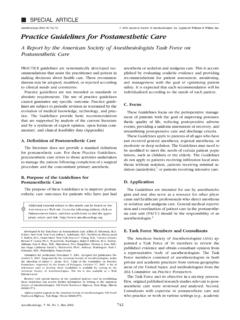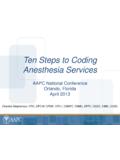Transcription of OHA Sepsis Data Dictionary - Ohio Hospital …
1 OHA Sepsis data Dictionary Sepsis Outcome Measures OHA will use the administrative database to determine the Sepsis incidence and mortality. No additional data submission is necessary for outcome measures. Sepsis Incidence Definition: the number of severe Sepsis or septic shock encounters per month Numerator: the number of patients admitted to the acute care setting with severe Sepsis or septic shock using the following ICD-9 codes ( Sepsis , severe Sepsis , septic shock). Denominator: Total number of inpatient encounters Sepsis Mortality Definition: Percent of patients with severe Sepsis or septic shock who expire during a Hospital admission Numerator: the number of patients admitted to the acute care setting with severe Sepsis or septic shock using the following ICD-9 codes ( Sepsis , severe Sepsis , septic shock) who died (discharge code of 20) during the Hospital stay. Denominator: the number of patients admitted to the acute care setting with severe Sepsis or septic shock using the following ICD-9 codes ( Sepsis , severe Sepsis , septic shock).
2 Sepsis Three Hour Bundle data Elements: Process Measures OHA is focusing on the 3 hour bundle in an effort to streamline data abstraction, therefore, you can submit your responses from the CMS Sepsis core measure. OHA is only collecting the total numerator and denominator for 4 of the data elements within this measure: initial lactate level collection, blood culture collection, broad spectrum or other antibiotic administration and crystalloid fluid administration. If you respond 1 to each of the following it is YES for that metric. If you respond 2 or 3 the following then it is NO. 1) Initial Lactate Level Collection: Definition: Documentation of collection of an initial lactate level between 6 hours prior and 3 hours following the presentation of severe Sepsis . Sample size: Prefer a minimum of 10 discharge charts per month but more would be desirable. You can use Sepsis charts used for core measure submission or any charts from other populations.
3 Excluded populations are patients with Palliative care order prior to 180 minutes from arrival. Allowable Values: 1 (Yes) An initial lactate level was drawn in the time window between 6 hours prior to and 3 hours following the presentation of severe Sepsis . 2 (No) An initial lactate level was not drawn in the time window between 6 hours prior to and 3 hours following the presentation of severe Sepsis , or unable to determine. Notes for Abstraction: If there are multiple lactate levels, only abstract the level drawn closest to the time of presentation of severe Sepsis . That lactate level is the initial lactate level for purposes of this data element. Do not use documentation such as Labs Drawn as it is not specific for lactate level. Similarly, do not use a physician order for lactate levels as it does not specify that lactate level was drawn; however, you may use a physician order that has a notation drawn or collected next to it.
4 Use the lactate level collection time documented in nursing notes, next to a physician order, or on laboratory reports. If a lactate level is ordered and there is an attempt to collect it, but the attempt results in failure to collect the specimen (too dehydrated to get a vein) or the specimen was contaminated during or after the draw, select Value 1. If a lactate level is drawn but there are no results in the record, choose Value 1. data Source: Laboratory Reports Nursing Notes Physician/APN/PA notes data Submission Frequency: Monthly by the end of month for previous month 2) Blood Culture Collection: Definition: Documentation of the collection of a blood culture. Sample size: Prefer a minimum of 10 discharge charts per month but more would be desirable. You can use Sepsis charts used for core measure submission or any charts from other populations. Excluded populations are patients with Palliative care order prior to 180 minutes from arrival.
5 Allowable Values: 1 (Yes) A blood culture was drawn in the time window between 48 hours prior to and 3 hours following the presentation of severe Sepsis . 2 (No) A blood culture was not drawn in the time window between 48 hours prior to and 3 hours following the presentation of severe Sepsis , or unable to determine. Notes for Abstraction: Use the blood culture collection documented in nursing notes or on laboratory culture or Gram Stain report documents. Do not use Labs Drawn or similar documentation, as it is not specific to blood culture. If a blood culture is ordered and there is an attempt to collect it, but the attempt results in failure to collect the specimen (too dehydrated to get a vein) or the specimen was contaminated during or after the draw, select Value 1. If there is supportive documentation that a blood culture was collected and it is the earliest mention of a blood culture, this date and time can be used, , BC sent to lab, blood culture received time.
6 Select Value 1. Do not use physician orders to determine a blood culture was collected, as they do not demonstrate collection of the blood culture. If the patient was started on antibiotics within 24 hours before presentation of severe Sepsis , begin abstraction of a blood culture 24 hours before the first antibiotic dose was given. If the patient received the first dose of antibiotics more than 24 hours prior to the time of presentation of severe Sepsis , choose Value 2. If the patient was not on antibiotics at the time of presentation of severe Sepsis , begin abstracting 24 hours prior to the time of presentation of severe Sepsis . Stop abstracting 3 hours after the presentation of severe Sepsis . data Source: Emergency Department record History and physical Laboratory report Microbiology report Nursing notes Progress notes data Submission Frequency: Monthly by the end of month for previous month 3) Broad Spectrum or Other Antibiotic Administration: Definition: Documentation of administration of a broad spectrum or other antibiotic intravenously in the time window 24 hours prior to and 3 hours following the presentation of severe Sepsis .
7 Sample size: Prefer a minimum of 10 discharge charts per month but more would be desirable. You can use Sepsis charts used for core measure submission or any charts from other populations. Excluded populations are patients with Palliative care order prior to 180 minutes from arrival. Allowable Values: 1 (Yes) A broad spectrum or other antibiotic was administered intravenously in the time window 24 hours prior to and 3 hours following the presentation of severe Sepsis . 2 (No) No antibiotic was administered intravenously in the time window 24 hours prior to and 3 hours following the presentation of severe Sepsis , or unable to determine. Notes for Abstraction: NOTE: To choose Value 1 , there must be a least one dose of the antibiotic given in the 24 hours preceding or 3 hours after the severe Sepsis presentation time. If one of the IV antibiotics listed on CMS data Dictionary Table (Please consult the most current CMS data Dictionary for this measure) was not given to the patient within 3 hours after presentation of severe Sepsis , locate the name or names of antibiotics given within the three hour time window and identify the class they belong to by consulting Appendix C, Table , which contains a crosswalk of generic and trade names for antibiotics by class.
8 If an antibiotic from a class in the left-hand column of the antibiotic combination table below was given, then look in the right-hand column of the antibiotic combination table for the classes of other antibiotics that must be administered in combination (2 antibiotics must be administered). There must be one antibiotic from a class in column A and one antibiotic from a class in column B administered. Review the chart to see that both drugs were given and if so, choose Value 1. If both drugs were not given, choose Value 2. If the patient received both an antibiotic listed on Table , , or in data element Broad Spectrum or Other Antibiotic Selection, and they also received an antibiotic not listed in any of those sources, abstract the antibiotic listed on Table , , or in the data element. Choose Value 2 if no antibiotic was given within the 24 hours preceding or 3 hours following the severe Sepsis presentation time. If antibiotics were administered in the prescribed time window both before and after severe Sepsis presentation, abstract only the dose closest to and preceding the time of presentation of severe Sepsis .
9 Antibiotic administration information should only be abstracted from documentation that demonstrates actual intravenous administration of the antibiotic. A physician order for IV antibiotics is not sufficient unless the antibiotic ordered was marked as given with date/time noted. Do not collect antibiotics documented on an operative report unless the surgeon states that the surgeon actually administered the dose. Do not cross reference between different sources to infer that an antibiotic was given intravenously if it was documented only with name/date/time given but no route indicated. Example: The route on the MAR for an antibiotic cannot be used as the route for a dose of that same antibiotic on another form. The method of designation of administration on hand-written or pre-printed forms such as MARs or eMARs, with pre-printed scheduled times for administration, must be clearly designated as given. The methods may vary.
10 Whatever method is used, it must be clear that the dose was administered. o Do not abstract test doses of antibiotics. o Do not abstract antibiotics from sources that do not represent actual administration. Examples that do not represent actual administration: Pre-Op Checklist states: X IV Started at 1730 X Preop Antibiotic Given at 1800 X Lab on Chart Operative report states: IV antibiotics were given prior to procedure data Source: Anesthesia record Entire Emergency Department record ICU flow sheet IV flow sheet Medication administration record Nurses notes Operating room record PACU/recovery room record Perfusion record Physician/APN/PA notes data Submission Frequency: Monthly by the end of month for previous month Table Antibiotic Monotherapy, Sepsis Antibiotic Selection Options (includes trade & generic name) Generic Name Crosswalk Doribax Doripenem Doripenem Doripenem Eratepenem Eratepenem Invanz Eratepenem Imipenem/Cilastatin Imipenem/Cilastatin Meropenem Meropenem Merrem Meropenem Primaxin Imipenem/Cilastatin Cefotaxime Cefotaxime Claforan Cefotaxime Ceftazidime Ceftazidime Ceftriaxone Ceftriaxone Fortaz Ceftazidime Rocephin Ceftriaxone Cefepime Cefepime Maxipime Cefepime Ceftaroline fosamil Ceftaroline fosamil Teflaro Ceftaroline fosamil Avelox Moxifloxacin Gatifloxacin Gatifloxacin Levaquin Levofloxacin Levofloxacin Levofloxacin Moxifloxacin Moxifloxacin Tequin Gatifloxacin Amoxicillin/clavulanate Amoxicillin/clavulanate Ampicillin/sulbactam Ampicillin/sulbactam Augmentin Amoxicillin/clavulanate Piperacillin/tazobactam Piperacillin/tazobactam Ticarcillin/clavulanate Ticarcillin/clavulanate Timentin Ticarcillin/clavulanate Unasyn Ampicillin/sulbactam Zosyn



